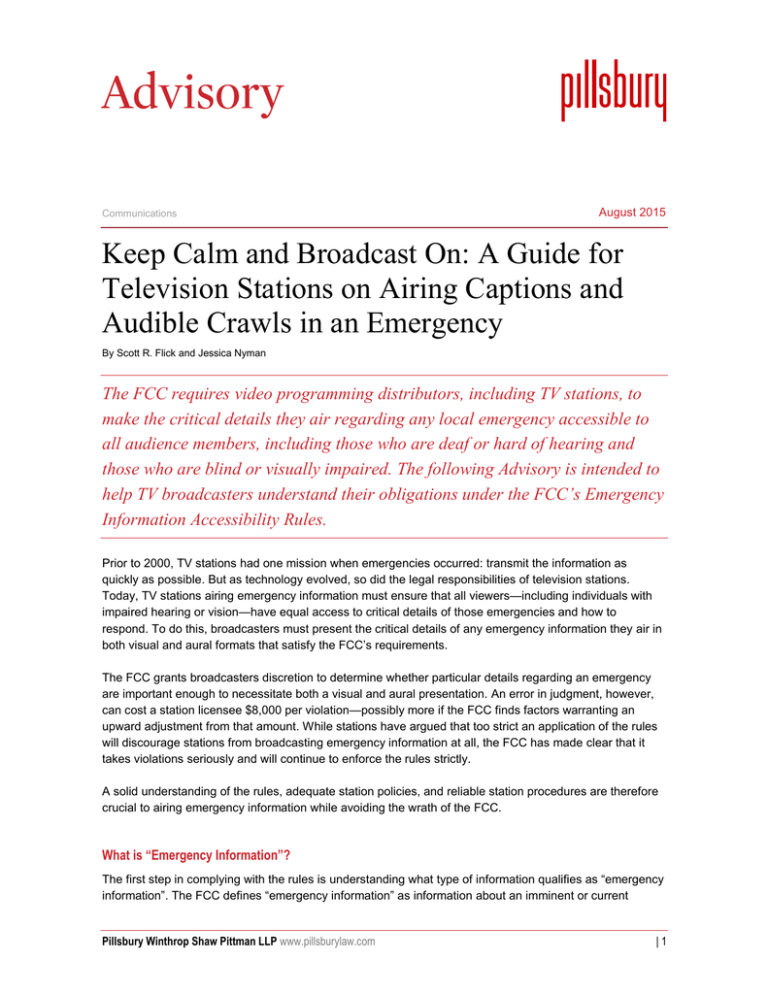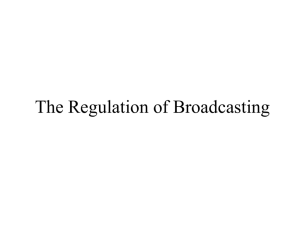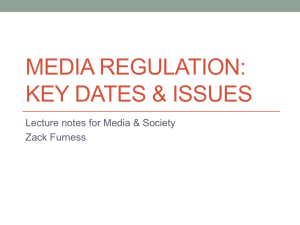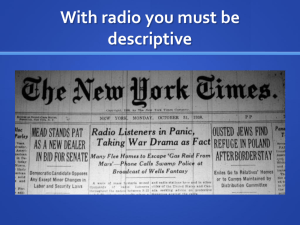
Advisory
Communications
Communications
August 2015
Keep Calm and Broadcast On: A Guide for
Television Stations on Airing Captions and
Audible Crawls in an Emergency
By Scott R. Flick and Jessica Nyman
The FCC requires video programming distributors, including TV stations, to
make the critical details they air regarding any local emergency accessible to
all audience members, including those who are deaf or hard of hearing and
those who are blind or visually impaired. The following Advisory is intended to
help TV broadcasters understand their obligations under the FCC’s Emergency
Information Accessibility Rules.
Prior to 2000, TV stations had one mission when emergencies occurred: transmit the information as
quickly as possible. But as technology evolved, so did the legal responsibilities of television stations.
Today, TV stations airing emergency information must ensure that all viewers—including individuals with
impaired hearing or vision—have equal access to critical details of those emergencies and how to
respond. To do this, broadcasters must present the critical details of any emergency information they air in
both visual and aural formats that satisfy the FCC’s requirements.
The FCC grants broadcasters discretion to determine whether particular details regarding an emergency
are important enough to necessitate both a visual and aural presentation. An error in judgment, however,
can cost a station licensee $8,000 per violation—possibly more if the FCC finds factors warranting an
upward adjustment from that amount. While stations have argued that too strict an application of the rules
will discourage stations from broadcasting emergency information at all, the FCC has made clear that it
takes violations seriously and will continue to enforce the rules strictly.
A solid understanding of the rules, adequate station policies, and reliable station procedures are therefore
crucial to airing emergency information while avoiding the wrath of the FCC.
What is “Emergency Information”?
The first step in complying with the rules is understanding what type of information qualifies as “emergency
information”. The FCC defines “emergency information” as information about an imminent or current
Pillsbury Winthrop Shaw Pittman LLP www.pillsburylaw.com
|1
Advisory
Communications
emergency that is “intended to further the protection of life, health, safety, and property.” A non-exhaustive
list of emergency situations that fall under this definition includes:
Weather situations, such as
Community situations, such as
Tornadoes
Widespread fires
Hurricanes
Discharge of toxic gases
Floods
Widespread power failures
Tidal waves
Industrial explosions
Earthquakes
Civil disorders
Icing conditions
Heavy snows
Severe thunderstorms
School closings and changes in
school bus schedules resulting from
severe weather or community
situations
Warnings and watches of impending
changes in weather
The FCC’s accessibility rules apply to emergency information that is primarily intended for a local
audience—i.e., an audience within the geographic area in which the emergency is occurring and where
victims may be temporarily relocated.
Visual Accessibility for the Hearing Impaired
Make Critical Details Visually Accessible Regardless of When the Information Is Presented
Whether the information is part of a regularly scheduled newscast, included in a live press conference, or
aired in a special announcement that interrupts regularly scheduled programming, broadcasters must
ensure that hearing impaired viewers have the same access to the critical details of the emergency as
other viewers.
The rules presume broadcasters will rely on their own good faith judgments in determining whether they
need to present particular details of an emergency. However, broadcasters must do more than simply
identify, in an accessible manner, the existence of an emergency. They must ensure that any critical
details they provide about an emergency are made accessible to all audience members. Critical details
include:
Specific details about the area affected by the emergency
Evacuation orders
Detailed descriptions of areas to be evacuated
Specific evacuation routes
Approved shelters or the way to take shelter in one’s home
Instruction on how to secure personal property
Road closures
How to obtain relief assistance
Pillsbury Winthrop Shaw Pittman LLP www.pillsburylaw.com
|2
Advisory
Communications
Do It by Any Means Necessary
Exactly how broadcasters provide the emergency information is up to them. For example, stations can
present the information through closed captioning, open captioning, or other methods such as slides,
scrolls, or crawls. The FCC has gone so far as to suggest that the information can be handwritten on a
chalkboard. What matters is that any critical details be broadcast in a visual format and track the aural
messages.
Keep in mind that whatever method a station chooses, it must find a way to present the emergency
information visually even if its preferred method fails. For example, if the Chyron operator is unavailable or
the closed captioning equipment is not functioning, the station must find an alternate way of visually
conveying the information. Stations should therefore anticipate the increased risk of power or equipment
failures in times of emergency and be prepared with a backup method.
In addition, TV stations that use a method other than closed captioning to present the information must
ensure that their emergency crawls, scrolls, or slides are not obscured by closed captions and vice versa.
There Are No Exceptions
All broadcasters are required to comply with these visual accessibility requirements. Because the rule does
not mandate the use of any particular technology, the FCC determined that exemptions were unnecessary.
Accordingly, even those exempt from other aspects of the closed captioning rules are required to visually
present emergency information contained in the audio portion of their programming.
Because there are no exceptions to the rule, viewers need not follow standard closed captioning complaint
procedures, which require sending complaints to the broadcaster before the FCC will consider them.
Instead, complaints may be filed directly with the FCC. Similarly, because the determination of whether a
violation has occurred does not require an assessment of captioning levels over a calendar quarter,
viewers do not have to wait until the end of the quarter to file their complaints.
Aural Accessibility for the Visually Impaired
Mirroring the accessibility requirements for the deaf and hard of hearing, TV stations must deliver aurally
emergency information that is presented visually to ensure critical details are accessible to individuals who
are blind or visually impaired. Critical details include:
The area affected by the emergency
Evacuation orders
Detailed descriptions of areas to be evacuated
Specific evacuation routes
Approved shelters or the way to take shelter in one’s home
Instruction on how to secure personal property
Road closures
How to obtain relief assistance
Pillsbury Winthrop Shaw Pittman LLP www.pillsburylaw.com
|3
Advisory
Communications
Emergency Information Presented in a Newscast
Under the FCC’s rules, emergency information presented visually during newscasts must be conveyed
aurally on the main program audio stream. This applies to regularly scheduled newscasts, as well as to
newscasts that interrupt regular programming.
Emergency Information Presented Outside of Newscasts
Under the current rules, broadcasters that provide emergency information outside of a newscast (for
example, in an on-screen crawl during regularly scheduled programming) must precede the information
with an aural tone to alert visually impaired viewers to seek an alternative information source, such as
radio. The FCC does not specify the particular aural tone to be used, but has acknowledged the current
industry practice of using three high-pitched tones.
Beginning November 30, 2015, the FCC’s “Audible Crawl Rule” will expand the current obligations so
that individuals with visual impairment can receive all emergency information from their televisions. The
Audible Crawl Rule will require broadcasters to aurally present on a secondary audio stream (“SAS”) any
emergency information that is provided visually in non-newscast programming. The station must insert an
aural tone (both on the main video stream and the SAS) before transmitting emergency information on the
SAS to differentiate between that information and the normal audio. This alerts the viewer to turn on the
SAS and focus on the emergency content.
In feeding audio to the SAS, TV stations do not need to provide a verbatim aural translation of textual
emergency information. However, the SAS audio must accurately and effectively communicate to blind or
visually impaired consumers the critical details of the emergency to the same extent that the information is
conveyed visually. To do so, the FCC permits, but does not require, the use of text-to-speech (“TTS”)
technologies as a method of providing an aural presentation of emergency information, so long as
information provided through TTS is intelligible and correctly pronounces relevant information such as the
names of shelters, school districts, streets, and proper names noted in the visual presentation.
Under the Audible Crawl Rule, broadcasters must convey the emergency information at least twice in full.
Additionally, emergency information presented on the SAS must supersede all other programming on the
SAS, including video description, foreign language translation, or duplication of the main audio stream. The
FCC encourages stations to convey emergency information more than twice in appropriate situations at
the broadcasters’ discretion—for example, when the SAS is not being used for video description or a
foreign language soundtrack.
Limited and Temporary Waivers of the Audible Crawl Rule
Earlier this year, the FCC granted certain waivers of the Audible Craw Rule that, at least temporarily, limit
the breadth of visual information that must be aurally conveyed on the SAS. These include:
Inherently Graphical Information:
The Audible Crawl Rule requires broadcasters to aurally convey on the SAS all emergency information
provided in the video portion of the programming. However, the FCC acknowledged that it is not yet
feasible for broadcasters to aurally convey certain visual but non-textual information, such as Doppler
radar and weather maps. To accommodate the shortcomings of existing technology, the FCC granted a
temporary waiver of the requirement to convey such non-textual information. Accordingly, broadcasters
Pillsbury Winthrop Shaw Pittman LLP www.pillsburylaw.com
|4
Advisory
Communications
have until November 2016 before the FCC will require them to aurally describe on the SAS critical details
that are conveyed solely by a map or other graphic display.
School Closures and Bus Schedule Changes:
As noted above, the FCC typically considers information about school closures and bus schedule changes
resulting from an emergency to fall within its definition of emergency information, meaning that stations
must aurally convey this information on the SAS. However, in response to industry concerns that including
such information on the SAS would be “prolonged and inefficient” and would “crowd out more important
emergency information,” the FCC has agreed to waive for the moment this requirement while the FCC
reconsiders the issue in a Second Further Notice of Proposed Rulemaking.
Don’t Panic
Emergencies are stressful, particularly for stations trying to transmit potentially life-saving information to
their local community while also staying on the air in a hurricane. All audience members, including those
with impaired hearing or vision, count on their local stations to keep them informed, and a well-meaning
station just trying to get emergency information out to its audience as quickly as possible can find itself in
hot water with the FCC if that message can only be understood by a portion of the audience.
Fortunately, stations can overcome this challenge by being well-prepared. The time to establish protocols
and procedures for transmitting emergency information is not in the midst of an emergency, but well before
the emergency occurs. Stations that train their employees for every eventuality, implement adequate
procedures, and regularly test their equipment for reliability will be able to weather the storm.
If you have any questions about the content of this Advisory, please contact the Pillsbury attorney with
whom you regularly work, or the authors below.
Scott R. Flick (bio)
Washington DC
+1.202.663.8167
scott.flick@pillsburylaw.com
Jessica Nyman (bio)
Washington DC
+1.202.663.8810
jessica.nyman@pillsburylaw.com
About Pillsbury Winthrop Shaw Pittman LLP
Pillsbury is a full-service law firm with an industry focus on energy & natural resources, media, financial
services including financial institutions, real estate & construction, and technology. Based in the world's
major financial, technology and energy centers, Pillsbury counsels clients on global business, regulatory
and litigation matters. We work in multidisciplinary teams that allow us to understand our clients’
objectives, anticipate trends, and bring a 360-degree perspective to complex business and legal issues—
helping clients to take greater advantage of new opportunities, meet and exceed their objectives, and
better mitigate risk. This collaborative work style helps produce the results our clients seek.
This publication is issued periodically to keep Pillsbury Winthrop Shaw Pittman LLP clients and other interested parties
informed of current legal developments that may affect or otherwise be of interest to them. The comments contained herein
do not constitute legal opinion and should not be regarded as a substitute for legal advice.
© 2015 Pillsbury Winthrop Shaw Pittman LLP. All Rights Reserved.
Pillsbury Winthrop Shaw Pittman LLP www.pillsburylaw.com
|5




